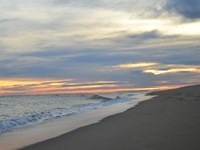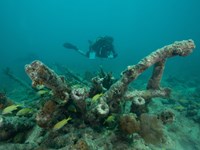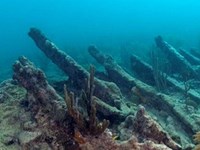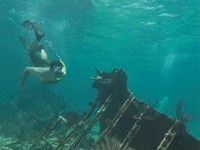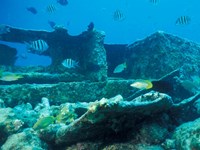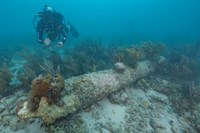Specific Shipwreck Places
- Dry Tortugas National Park
Bird Key Wreck
- Cape Cod National Seashore
Head of the Meadow Beach
- Cape Cod National Seashore
Marconi Beach
- Sleeping Bear Dunes National Lakeshore
Francisco Morazan
- Locations: Sleeping Bear Dunes National Lakeshore

Resting about 300 yards off the southern coast of South Manitou Island is one of of Michigan's most visible shipwrecks, the Francisco Morazan.Gambling with late season Great Lakes weather, but wanting to make one last trip before winter, the Francisco Morazan left Chicago on November 27, 1960. The steel-hulled Liberian freighter was bound for Holland via the St. Lawrence Seaway loaded with 940-tons of general cargo.
- Biscayne National Park
Lugano
- Biscayne National Park
Erl King
- Biscayne National Park
Arratoon Apcar
- Biscayne National Park
Mandalay
- Biscayne National Park
Alicia
- Biscayne National Park
19th Century Wooden Sailing Vessel
Stories About Shipwrecks
- War In The Pacific National Historical Park
The Sinking of the SMS Cormoran and the First US Shots of World War I
- Type: Article
- Locations: War In The Pacific National Historical Park

On December 13, 1914, the German auxiliary cruiser SMS Cormoran, out of fuel and cut off from Germany by World War I, took refuge from Japanese warships in Guam. The ship spent the next two years interned in Apra Harbor. When the United States declared war on Germany in 1917, the Cormoran's captain blew up the ship rather than let her fall into enemy hands.
- Indiana Dunes National Park
Tragic Wreck of the Flying Cloud Schooner
- Type: Article
- Locations: Indiana Dunes National Park
Thousands of ships have been wrecked in the Great Lakes. Many met their fate as shipping and transportation peaked on the lakes during the late 19th and early 20th centuries. With them drowned countless sailors, captains, passengers and crew— victims of a time before modern forecasting and navigation. Learn about a wreck that occurred at Indiana Dunes in 1857.
- Type: Article
- Locations: Acadia National Park
- Offices: Archeology Program, Submerged Resources Center

A beached shipwreck on Sand Beach in Acadia National Park was a staple of the landscape that shaped the imaginations of visitors of all ages. They could explore along the beach, wondering: Where did it come from? Whose ship was it, and why did it end up on here? If the ship’s wooden planks could talk, what stories would they tell?
- Type: Article
- Locations: Acadia National Park, Cape Cod National Seashore, Cape Lookout National Seashore, Cumberland Island National Seashore, Fire Island National Seashore, Gulf Islands National Seashore
- Offices: Archeology Program, Submerged Resources Center

Climate change compels National Park archeologists to use science to save valuable data from deteriorating and disappearing back into the sea. In response, the National Park Service’s Submerged Resources Center (SRC) and its partners are expanding their shipwrecking timber tracking initiative, the Shipwreck Tagging Archaeological Management Program (STAMP), to encompass all national parks with bodies of water.
- Acadia National Park
Monitoring the Sand Beach Shipwreck
- Type: Article
- Locations: Acadia National Park
- Type: Article
- Locations: Dry Tortugas National Park
- Offices: Archeology Program

On January 13, 1742 HMS Tyger ran aground on coral reefs near Garden Key. The crew desperately heaved the heavy cannon and anchors offboard to lighten the load, and tried shifting the vessel off its perch. But it was no use. HMS Tyger was stuck – really stuck – and friends were 700 miles away. Hundreds of years later, archeologists identified the shipwreck and have learned much more about the crew’s plight on the isolated island chain.
- Dry Tortugas National Park
National Park Service archeologists identify sunken British warship in Dry Tortugas National Park
- Type: News
- Locations: Dry Tortugas National Park
- Date Released: 2024-03-14
- American Battlefield Protection Program
Uncovering WWII Shipwrecks in Chuuk Lagoon
- Type: Article
- Offices: American Battlefield Protection Program

The NPS's American Battlefield Protection Program awarded a 2021 Preservation Planning Grant to the University of Guam. The university plans to further document the remnants of World War II shipwrecks in the Chuuk Lagoon and shed light on how the conflict between the US and Japan impacted the Chuukese.
- Type: Article
- Locations: Point Reyes National Seashore
- Offices: Archeology Program

The Tamál-Húye Archeological Project focuses on intercultural interactions and processes of culture change and continuity in sixteenth-century northern California resulting from the shipwreck of the Manila galleon San Agustín, which occurred in tamál-húye, the Coast Miwok name for present-day Drakes Bay, in Point Reyes National Seashore, in 1595.
Last updated: August 5, 2023


